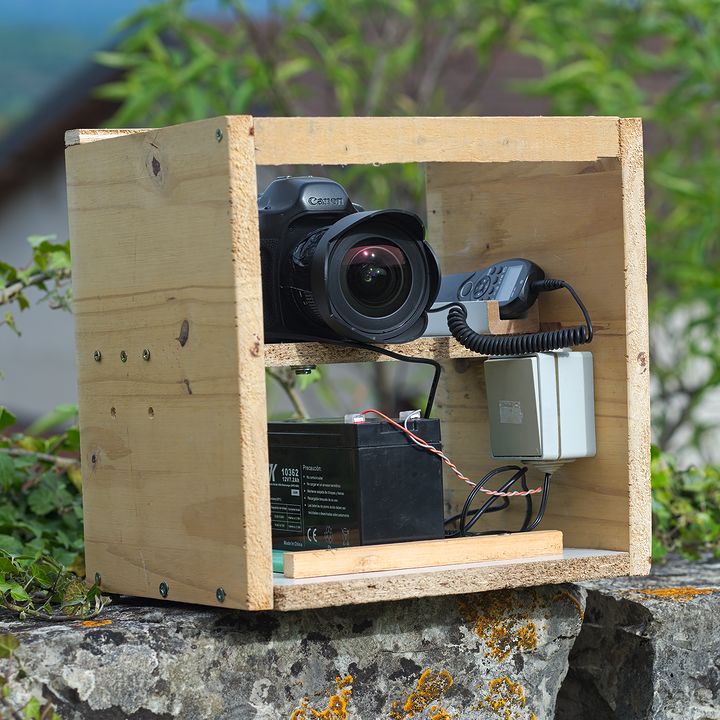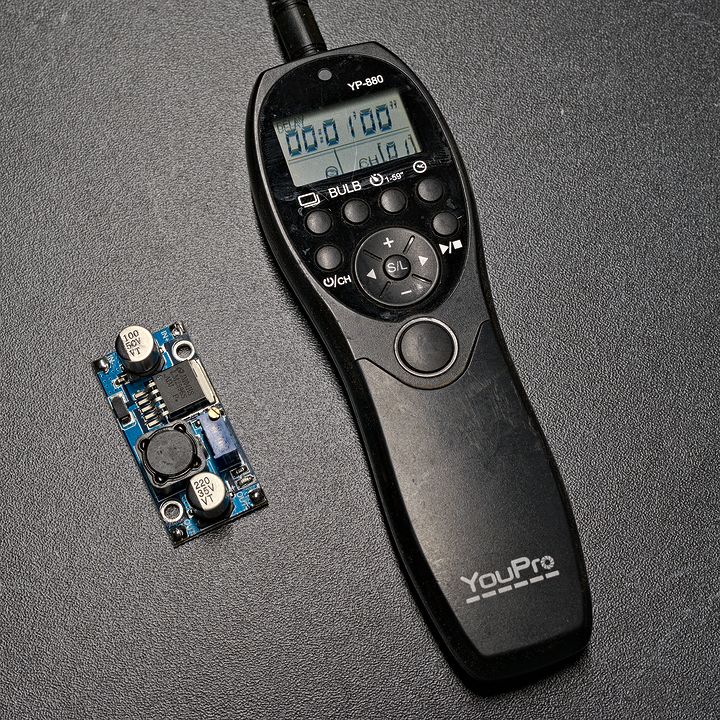I enjoy landscape timelapses, I can watch them for a long time on the web.

The buck-converter is placed inside the salvaged weatherproof wall switch (grey, right of the picture)
The project
I decided to try by myself to make a long timelapse, i.e. more than one hour, and with high resolution pictures, not just an accelerated movie.
This was the perfect usage for the Canon EOS 5D an a Samyang 14mm lens which were getting dust in a closet.
At first I tried a very simple setup: put the camera on a flat surface, with a full battery of course, some CompactFlash card and plugged in an electronic remote control to shoot every two minutes.
The battery (which was newer than the camera) lasted 5 hours, for 140 pictures. Not bad, but not enough, it died during the night and I wanted to record the sunrise! As I want to use my rig far in the countryside I have to do better with the power source.
So I bought online an external power kit with a USB converter to power my camera with a powerbank. The kit consist of a plastic dummy battery with a cable attached to a male jack barrel, and another piece, the 5V to 8V converter, with a female jack barrel at one end and a USB plug at the other end.
I quickly understood that the current converter was a piece of shit, unable to drive the camera and drawing too much current (and in a weird way) from every USB power source I tried. I got rid of the converter and bought a few naked buck-converters online, and a small 12V dry lead-acid battery at the same time. With the buck-converter tuned to deliver roughly 8 volts from the battery, I could try again my camera!
Next evening I put my rig on a window sill, and started the remote. One days and half after, the 16GB card was full of 1340 raw pictures!

YouPro YP-880 remote control and cheap buck-converter used for the project
Camera and lens settings
The EOS 5D is a pretty simple camera and the Samyang lens is fully manual so the settings were straightforward: Aperture priority, so the shutter speed is variable according to the brightness of the scene. The weather was grey this days so I set the sensibility to ISO 200, as this camera don’t have an auto-ISO mode. The lens aperture was set to f/5.6 to have the best resolution, as this sample is a bit decentered and so very soft in the left side. Maybe overkill because the camera was tightly screwed to a wood sheet, but I activated the mirror lock-up, an interesting function combined with the usage of the remote, see below. In another hand the mirror lock-up is probably why the battery ran flat very rapidly in my first try (it is using a electromagnet to keep the mirror up).
Remote control settings
The YouPro YP-880 remote has an interesting timelapse mode with two nested loops:
Screen 1 [DELAY]
The delay to run the loop after pressing the start button
Screen 2 [LONG]
The length of the signal sent to the camera to activate the shutter, useful when using the bulb mode, was not my case so I put 0 here.
Screen 3 [INTVL]
The interval between 2 actuations in a sub-loop, I put 1 second because I wanted to lock-up the mirror 1 second before taking the picture.
Screen 4 [N1]
Number of runs for the sub-loop, in my case it is 2: one for the mirror, one for the picture.
Screen 5 [RE]
The time between two sub-loop repetitions, 1mn30s in my case.
Screen 6 [N2]
Number of runs for the main loop, I put -- (two dashes, like no limit) because I wanted to check when the camera will run out of storage or battery.
Post-production
With RawTherapee and FFmpeg, but this is for a future article!
Next?
I see multiple improvements to make in order to have more flexibility in the making of pictures, storage, and remote control, all based on a Raspberry Pi and gphoto2. I also plan to use a mechanical operated lens cap to cover the front lens element between the shots to protect it from the sun, to be able to shot backlit without burning the sensor.
